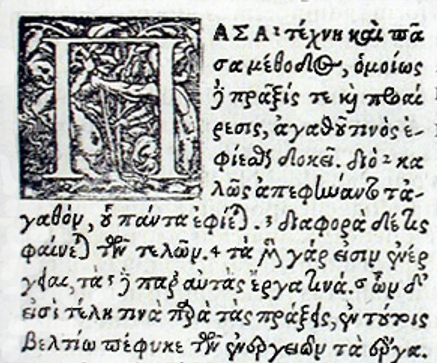Greek ligatures on:
[Wikipedia]
[Google]
[Amazon]
 Greek ligatures are graphic combinations of the letters of the Greek alphabet that were used in medieval handwritten Greek and in early printing.
Greek ligatures are graphic combinations of the letters of the Greek alphabet that were used in medieval handwritten Greek and in early printing.
 Greek ligatures are graphic combinations of the letters of the Greek alphabet that were used in medieval handwritten Greek and in early printing.
Greek ligatures are graphic combinations of the letters of the Greek alphabet that were used in medieval handwritten Greek and in early printing. Ligatures
Ligature may refer to:
* Ligature (medicine), a piece of suture used to shut off a blood vessel or other anatomical structure
** Ligature (orthodontic), used in dentistry
* Ligature (music), an element of musical notation used especially in the me ...
were used in the cursive
Cursive (also known as script, among other names) is any style of penmanship in which characters are written joined in a flowing manner, generally for the purpose of making writing faster, in contrast to block letters. It varies in functionalit ...
writing style and very extensively in later minuscule
Letter case is the distinction between the letters that are in larger uppercase or capitals (or more formally ''majuscule'') and smaller lowercase (or more formally ''minuscule'') in the written representation of certain languages. The writing ...
writing. There were dozens of conventional ligatures. Some of them stood for frequent letter combinations, some for inflectional endings of words, and some were abbreviations of entire words.
History
In early printed Greek from around 1500, many ligatures fashioned after contemporary manuscript hands continued to be used. Important models for this early typesetting practice were the designs ofAldus Manutius
Aldus Pius Manutius (; it, Aldo Pio Manuzio; 6 February 1515) was an Italian printer and humanist who founded the Aldine Press. Manutius devoted the later part of his life to publishing and disseminating rare texts. His interest in and preserv ...
in Venice, and those of Claude Garamond in Paris, who created the influential Grecs du roi typeface in 1541. However, the use of ligatures gradually declined during the 17th and 18th centuries and became mostly obsolete in modern typesetting. Among the ligatures that remained in use the longest are the ligature Ȣ for ου, which resembles an ''o'' with an ''u'' on top, and the abbreviation ϗ for ('and'), which resembles a κ with a downward stroke on the right. The ου ligature is still occasionally used in decorative writing, while the abbreviation has some limited usage in functions similar to the Latin ampersand
The ampersand, also known as the and sign, is the logogram , representing the conjunction "and". It originated as a ligature of the letters ''et''—Latin for "and".
Etymology
Traditionally in English, when spelling aloud, any letter that ...
(&). Another ligature that was relatively frequent in early modern printing is a ligature of Ο with ς (a small sigma ''inside'' an omicron) for a terminal ος.
The ligature for , now called stigma, survived in a special role besides its use as a ligature proper. It took on the function of a number sign for "6", having been visually conflated with the cursive form of the ancient letter digamma, which had this numeral function.
Computer encoding
In the modern computer encoding standard Unicode, the abbreviation has been encoded since version 3.0 of the standard (1999). An uppercase version was added in version 5.1 (2008). A lower and upper case "stigma", designed for its numeric use, is also encoded in Unicode. Letters derived from the ου ligature exist for use in Latin, and for Cyrillic, though not for Greek itself. Some attempts have been made at recreating typesetting with ligatures in modern computer fonts, either through Unicode-compliant OpenType glyph replacement, or with simpler but non-standardized methods of glyph-by-glyph encoding.e.g. ; Greek digraphs ; Latin and Cyrillic Ou digraphsExample images
Other examples
See also
*iota adscript
The iota subscript is a diacritic mark in the Greek alphabet shaped like a small vertical stroke or miniature iota placed below the letter. It can occur with the vowel letters eta , omega , and alpha . It represents the former presence of ...
, which is written with a ligatured iota:
* iota subscript, also written with a ligatured iota:
* Tau-Rho
The staurogram (⳨), also monogrammatic cross or ''tau-rho'', is a ligature composed of a superposition of the Greek letters tau (Τ) and rho (Ρ).
Early occurrence and significance
The symbol is of pre-Christian origin. It is found on cop ...
* Chi-Rho
* Orthographic ligature
In writing and typography, a ligature occurs where two or more graphemes or letters are joined to form a single glyph. Examples are the characters æ and œ used in English and French, in which the letters 'a' and 'e' are joined for the first ...
References
External links
*{{Commons-inline Typographic ligatures Greek alphabet de:Griechisches Alphabet#Ligaturen